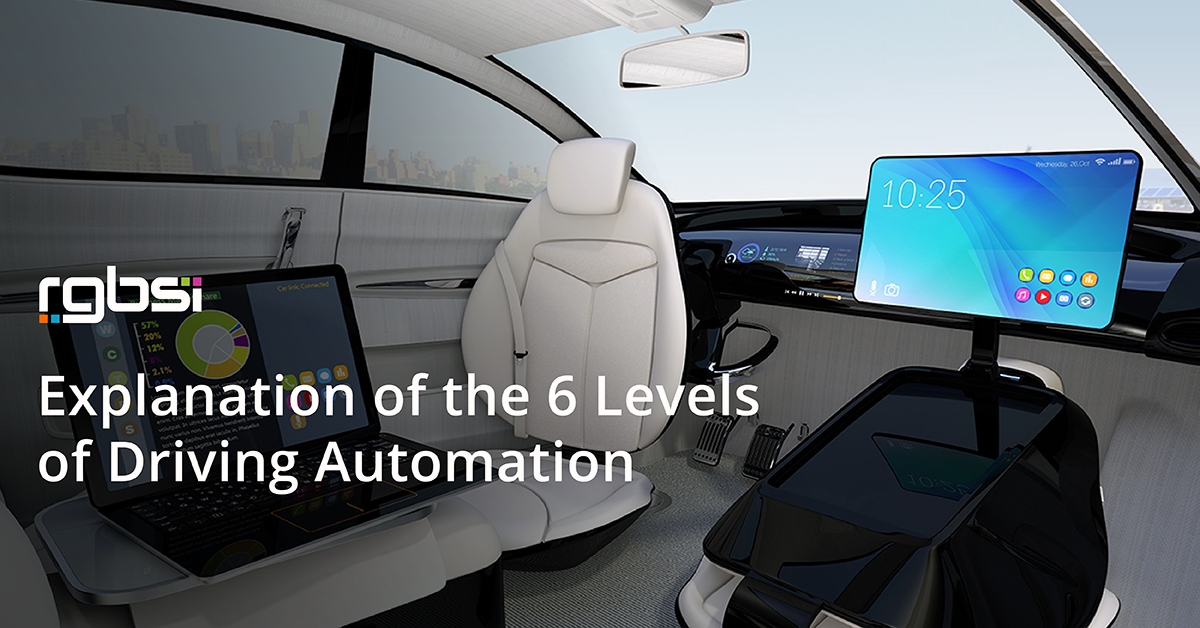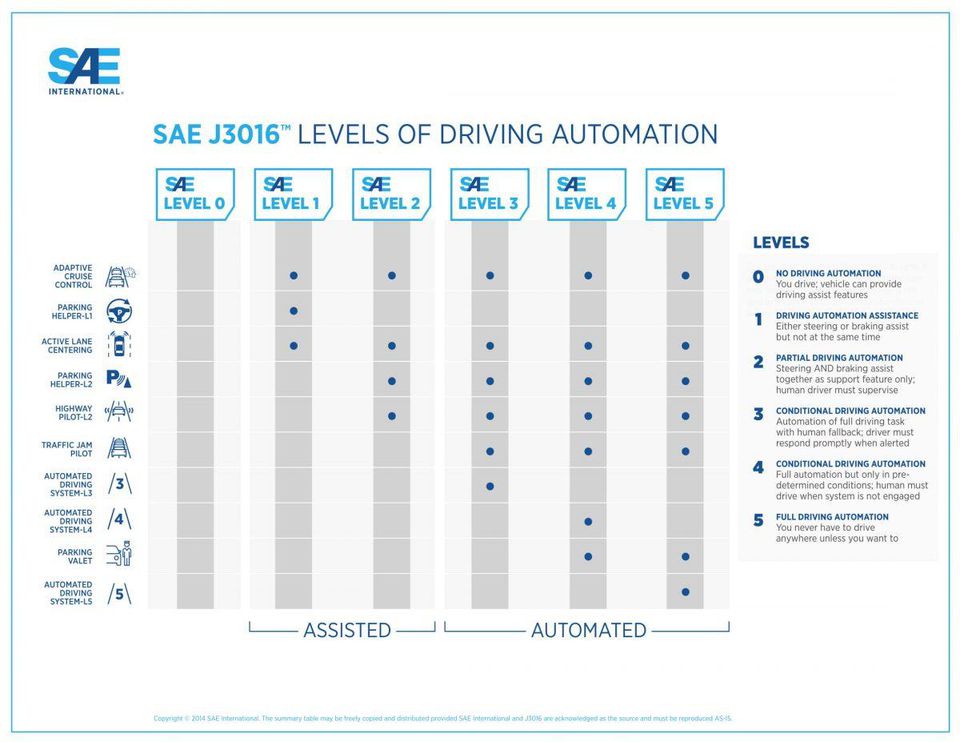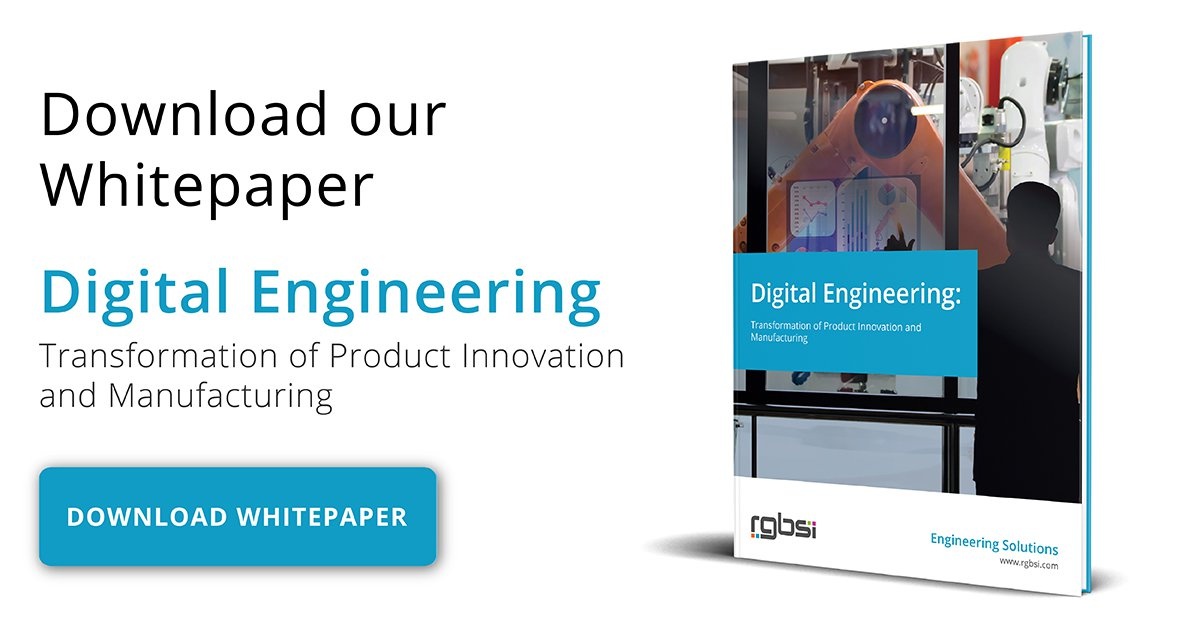
It is no surprise that self-driving vehicles, autonomous vehicles, automated driving, or whatever you choose to call it, continues to be put in the spotlight as smart technology disrupts automotive sectors. As automakers and innovative tech companies continue to converge, the progression of self-driving features continue to emerge. The J 3016-2018 guidelines established by SAE (Society of Automotive Engineers) refers to this as the levels of driving automation. In reference to vehicle systems, there is a difference between assisted driving technology and automation driving technology:
- Assisted driving technology: technology that assists humans in the driving process, but still requires a driver to make judgements and operate a vehicle (levels 1 and 2).
- Automation driving technology: artificial intelligence (AI) technology that vehicles use to intervene, make decisions, and control operation (levels 3-5).
SAE determines the level of intelligence in a vehicle by denoting automation capabilities with a rank 0, 1,2,3,4, or 5, where 0 represents no automation and 5 represents full automation. The guidelines were established to facilitate consistency across engineering, media, and legal communications. Here is an explanation of each of the 6 automation levels that are impacting the way of driving.
(Source: SAE International and J3016)
Level 0: No Automation
Level 0 indicates that a vehicle does not have any assisted or automated driving technologies. All actions of the vehicle are dictated by a human. For example, a human must manually control speed, braking, and make stopping judgements. This also includes cars with features such as conventional cruise control systems because they do not operate unless they are set/adjusted by a human.
Example of Level 0
A base model vehicle with conventional cruise control.
Level 1: Assisted Driving Automation
Level 1 vehicles have one or more assisted driving technologies such as adaptive cruise control and/or parking sensors. In addition to maintaining a preset speed like conventional cruise control systems, adaptive cruise control systems have the ability to adjust the vehicle’s speed and maintain adequate stopping distances. As this function is capable of slowing a vehicle down, a driver is still required to be attentive and manage brake pressure based on the given variables. Parking sensors detect objects in a driver’s parking path and alert the driver with a warning sounds. This is designed to assist drivers but the driver must still physically maneuver the car when parking. Many of the vehicles we see on the road today are considered a driving automation level 1 by SAE rankings.
Example of Level 1
2018 Honda Civic with adaptive cruise control.
Level 2: Partial Automation
Level 2 vehicles have two or more assisted driving technologies that work together simultaneously. For example, a level two vehicle can determine the speed of traffic ahead to coordinate its acceleration and steering on the highway, but the driver is required to be alert at all times to intercept when necessary. These vehicles are only capable of self-driving under certain conditions.
EXAMPLE OF LEVEL 2
2018 Tesla Model S with the Autopilot system that has lane changing, adaptive cruise control, and self-parking functions.
Level 3: Conditional Automation
Level 3 vehicles have limited automation driving functionality under certain conditions. The vehicle has the ability to make certain decisions without human judgement using sensors such as LiDAR. Humans are required to be on standby in case something doesn’t go as intended, but the vehicle takes full control of operating when certain conditions are met during a route. An example of conditional automation is Audi’s AI traffic jam pilot. The system can intervene at the point on a highway when a traffic jam is met and crawls inch by inch moving through it. Once traffic is cleared, the car alerts the driver to take back over as the condition is no longer met for it to operate on its own. The vehicle only monitors the environment under certain conditions, while all other circumstances fall on the driver.
EXAMPLE OF LEVEL 3
2019 Audi A8 with AI and hybrid drive is the first level 3 available to the market.
Level 4: High Automation
Level 4 vehicles have full automation driving technology functionality in most conditions. However, under select circumstances human oversight is required, such as driving on back roads or if a blizzard were to occur and cause poor visibility. For instance, a driver may control all the movements of a vehicle on back roads and then transition full control over to the vehicle for the highway portion of the journey. The driver becomes a passenger when the vehicle is in self-driving mode under the established conditions and human input is not required.
EXAMPLE OF LEVEL 4
Hyundai’s NEXO is currently being tested as a Level 4 car.
Level 5: Full Automation
Level 5 vehicles have full automation technology and require no involvement of humans. In comparison to level 4 cars, these cars have much more advanced environmental detection systems with the ability to operate under all conditions. An example of this would be the vehicle’s ability to operate autonomously through elevated terrains. Since the function of the driver is completely eliminated, the vehicle does not have traditional parts such as a steering wheel, brake and acceleration pedals, or gear shift that cater to a human operation. Can you image not having to drive anywhere again unless you really wanted to?
EXAMPLE OF LEVEL 5
This is non-existent but there are several automakers racing to the level 5 finish line. With integration of more V2V and V2I technology in place to mitigate risks give level 5 vehicles a shot in the future.
Conclusion
Currently, the highest automation level available to the public is a level 3 vehicle. Chances are if you have a car that was made in 2017 or after, it has level 2 automation technology built in. Level 2 vehicles are the current sweet spot for many automakers.
Conclusively, SAE’s levels of driving automation provide guidelines for categorizing the evolution of vehicles and their autonomous capabilities. Level 0 vehicles provide no automation and require full human control to operate. Level 1 and 2 vehicles both include assisted driving technologies, but level 2 vehicles differ in which the technologies work simultaneously together. Level 3, 4, and 5 vehicles include automation driving technologies. Level 3 vehicles provide limited automation capabilities that are conditional, level 4 vehicles provide full automation under most circumstances, and level 5 vehicles provide full automation under all circumstances.
Robust self-driving vehicle features continue to progress with the diffusion of innovative technology in engineering application. There is still a long road ahead in validating the safety of self-driving systems, but each step of progress brings the world closer to a driverless future of mobility.
About RGBSI
At RGBSI, we deliver total workforce management, engineering, quality lifecycle management, and IT solutions that provide strategic partnership for organizations of all sizes. As an organization of engineering experts, we understand the importance of modernization. Our engineering solutions provide clients with agility and enhancement through optimizing the value chain to meet industry protocols and full product specifications. Learn more about our automation and digital engineering services












